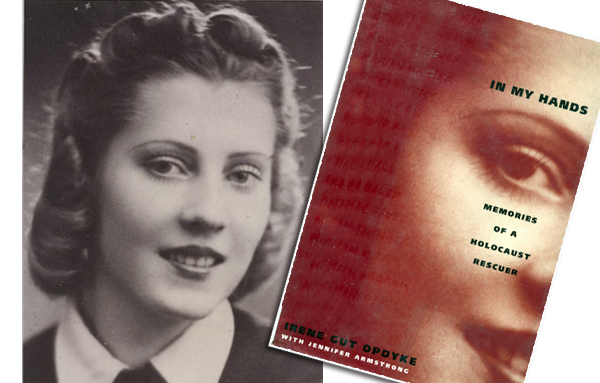“In my Hands: Memories of a Holocaust Rescuer” by Irene Gut Opdyke is available at the Fort Vancouver Regional Library, the Camas Public Library, at bookstores and on Amazon.com in paperback or in e-book format.
Reach Jeannie Smith at ireneopdyke@gmail.com.
Growing up, Jeannie Smith of Woodland didn’t realize her mother was a hero.
It wasn’t until Jeannie was 14 and overheard her mother talking on the phone about atrocities in Nazi-occupied Poland during World War II that she began to discover her mom’s brave deeds.
Irene Gut didn’t plan to be a hero, but a Nazi officer’s savagery pushed her into the Resistance. Upon her mother’s death in 2003, Jeannie resolved to keep her mother’s story alive. She has been traveling around the country doing just that ever since.
Irene grew up in a Catholic family in Poland, the eldest of five sisters. After high school, the 17-year-old moved to another city to attend nursing school. Within a few days of her arrival, the Germans invaded Poland.
It was September 1, 1939 — and Irene’s life changed overnight. She volunteered for the Resistance, but she was captured and raped by Russian soldiers who left her for dead in the snow.
Her life took another turn when she was captured by German soldiers and forced to work in a munitions factory, standing on her feet for long hours. In exhaustion, she fainted, but fearing that she would be shot, she insisted she could work. German officer Major Eduard Rügemer took pity on the girl, who was blond and spoke excellent German. He gave her a job in an officers’ dining room.
While waiting on tables, Irene overheard vital German information, and passed it along to the Resistance. She looked Aryan. The Germans didn’t suspect her.
In her memoir, Irene wrote: “You must understand that I did not become a resistance fighter, a smuggler of Jews, a defier of the SS and the Nazis, all at once. One’s first steps are always small.”
She started by smuggling food from the dining room and placing it under the fence of the Jewish ghetto. When she witnessed a Nazi officer snatch an infant from his Jewish mother’s arms, toss him into the air and shoot him like a clay pigeon, Irene resolved to help the Jews however she could.
Rügemer also arranged for Irene to work in a laundry. There she befriended many Jews who lived in the ghetto and were forced to work for the Germans. While waiting tables in the German officers’ dining room, she overheard that the Jewish ghettos were slated to be emptied by killing Jews and sending others to camps. How could she save her Jewish friends? Where could she hide them?
A few days later, Irene had her answer when Rügemer promoted her to be his housekeeper. It was a large house with many floors and a basement.
Irene borrowed a cart and horse in the guise of doing errands for Rügemer. She smuggled 12 Jewish friends — two at a time — hidden underneath blankets in the cart.
She hid them in the basement literally under the German officer’s nose. Each day after Rügemer left the house, Irene let her friends out of their hiding place, and they helped her with the many household chores. She always locked the front door so that Rügemer would have to knock to be let in.
One day when Irene was running errands, she and many other Poles were pushed to a public square and forced to watch the hanging of a Jewish family and the Christian family that had hidden them. She knew the same fate awaited her if she were caught.
Irene returned to the house, but she was so shaken that she forgot to lock the door. She and her Jewish friends were working in the kitchen when the German officer walked in. His jaw dropped when he realized that Irene was hiding Jews under his own roof.
She begged him to spare the lives of her Jewish friends. He would keep her secret for a price: She must agree to be his mistress. She was a teenager and he was an old man, but she didn’t know how else to save her friends.
In 1944, as the war was nearing an end, Russian soldiers were moving into the area, pushing the Germans out of Poland. Rügemer was preparing to leave the house and to move his unit. Irene needed to move her Jewish friends to safety. She contacted the Resistance and safely brought her 12 friends to hide in the forest.
Irene left her friends with the Resistance and set out to find her family, but she was arrested by the Soviets. Because she was known to be the mistress of a high-ranking German officer, the Russians believed she was a spy and planned to send her to Siberia.
One of her Jewish friends who was working for the Soviets recognized her. He smuggled her out of the Soviet camp and moved her into Germany to a camp for displaced Jews. To hide her identity, Irene dyed her hair black and was given false papers.
She was interviewed by William Opdyke, an American who worked for the United Nations. He heard her story and encouraged her to emigrate to the U.S.
Irene discovered that both of her parents were dead, but she couldn’t find any word of her sisters.
Still unable to find her sisters, in 1949 she boarded a ship bound for New York City. Although Irene didn’t know anyone in New York and didn’t speak English, she did speak Yiddish, and she found work at a garment factory.
One day, she coincidentally ran into Opdyke, the kind American who had encouraged her to emigrate. They were married in 1956 and had one child, Jeannie.
For many years, Irene didn’t share her story. But in 1972, when she read about people claiming the Holocaust never happened, she began accepting speaking engagements in schools to share her story. Soon she was speaking all over the country.
So many people asked Irene for her story that in 1999 she wrote her memoir and aimed it at young adult audiences. More than 1 million copies of “In My Hands: Memories of a Holocaust Rescuer” have been sold. It is available in bookstores, online and at the Fort Vancouver Regional Library and the Camas Public Library. “Irena’s Vow,” a drama based on her story, played on Broadway in 2009.
The Israeli Holocaust Commission named Irene as one of the “Righteous Among the Nations,” an honor bestowed upon Oskar Schindler and other gentiles who risked their lives to save Jewish lives during the Holocaust.
Irene was presented with Israel’s highest award, the Medal of Honor. A permanent exhibit in the U.S. Holocaust Memorial Museum in Washington, D.C. tells her story.
Jeannie Smith shares her mother’s passion for the story so that younger generations will know the horrors that occurred at the hands of the Nazis 70 years ago.
Irene wrote in her memoir: “This is my will: to do right; to tell you; and to remember.”
Susan Parrish: 360-735-4530 or susan.parrish@columbian.com




